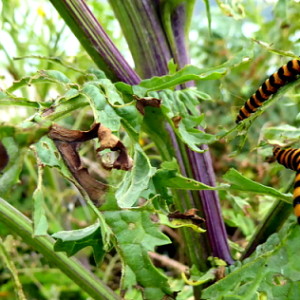Spots and stripes
Both are warning signals: I taste bad!
For weeks now I've been examining every ragwort plant I see for these stripey caterpillars, in vain until I heard where they could be found. So I spent a happy half hour on the breakwater where ragwort grows in profusion finding cinnabar moth imagos (the adult form) and lots of caterpillars too.
Ragwort has been demonized by the equestrian lobby because it's toxic and can kill horses when cut and dried with hay. Alive and growing, horses avoid it but all the same people are encouraged to root it out wherever seen whether grazed or not. Many believe it to be a 'notifiable weed' - it's not, see here, and there is NO obligation, or need, to remove it from public spaces.
There are many other toxic plants around us such as foxglove, giant hemlock and hemlock water dropwort and none of those possess ragwort's delightful association with the cinnabar moth.
Cinnabar moths and their caterpillars derive their toxicity from eating ragwort and they advertise the fact with their striking uniforms. At least 30 other species of invertebrate are dependent on ragwort as a food source and many bees and wasps use it for nectar.
The caterpillars are feisty little things and twitch violently when they sense your presence. They have enormous appetites and strip the plants of leaves very fast - for this reason cinnabar moths were introduced to the USA to control the growth of ragwort. If people but realised this it would make a lot of sense to leave the plants for the moths and they would do the work of removal. Extra shows them at work) As it is the cinnabar population in the UK has dropped dramatically as a result of the deliberate destruction of its food plant.


Comments
Sign in or get an account to comment.


